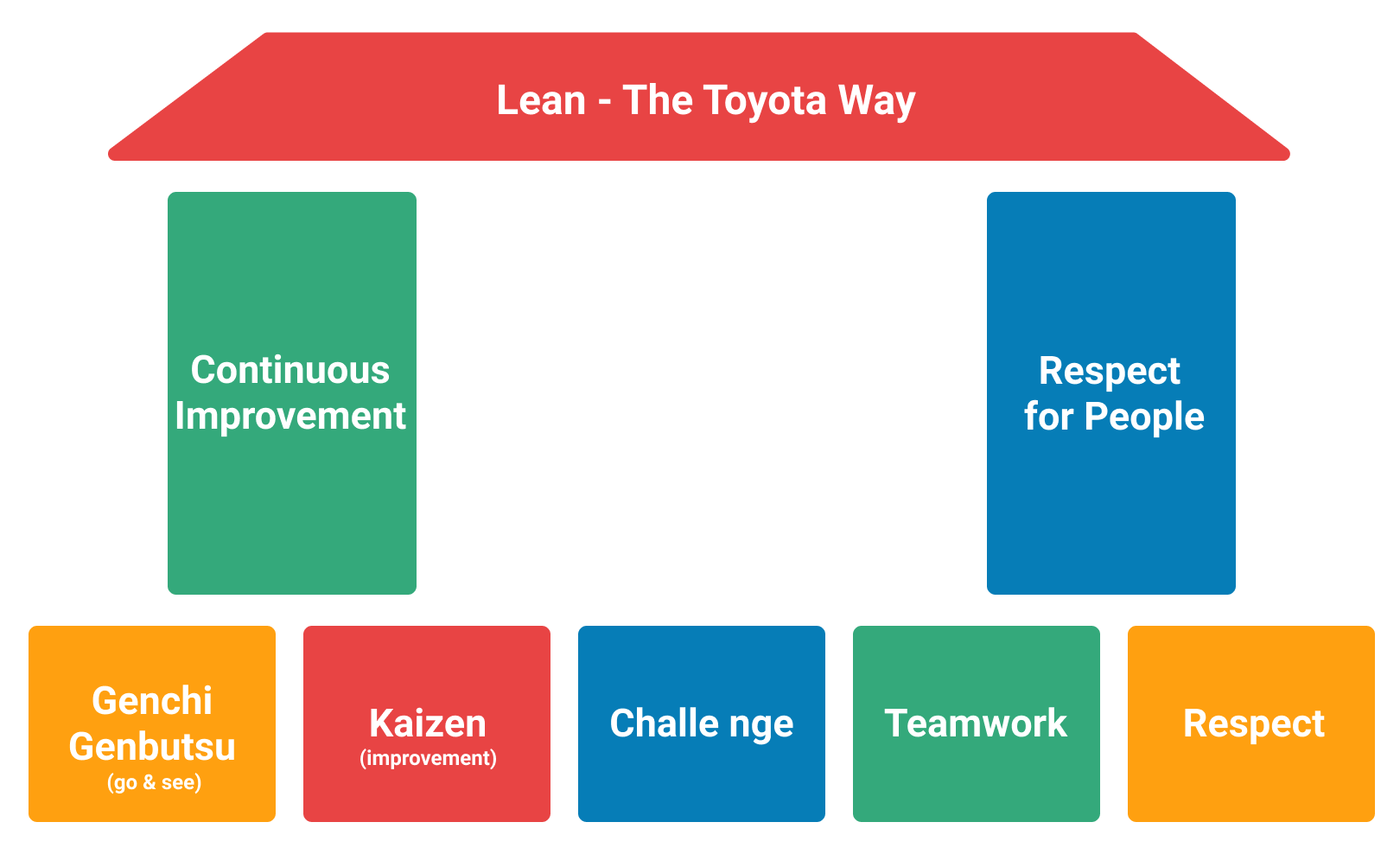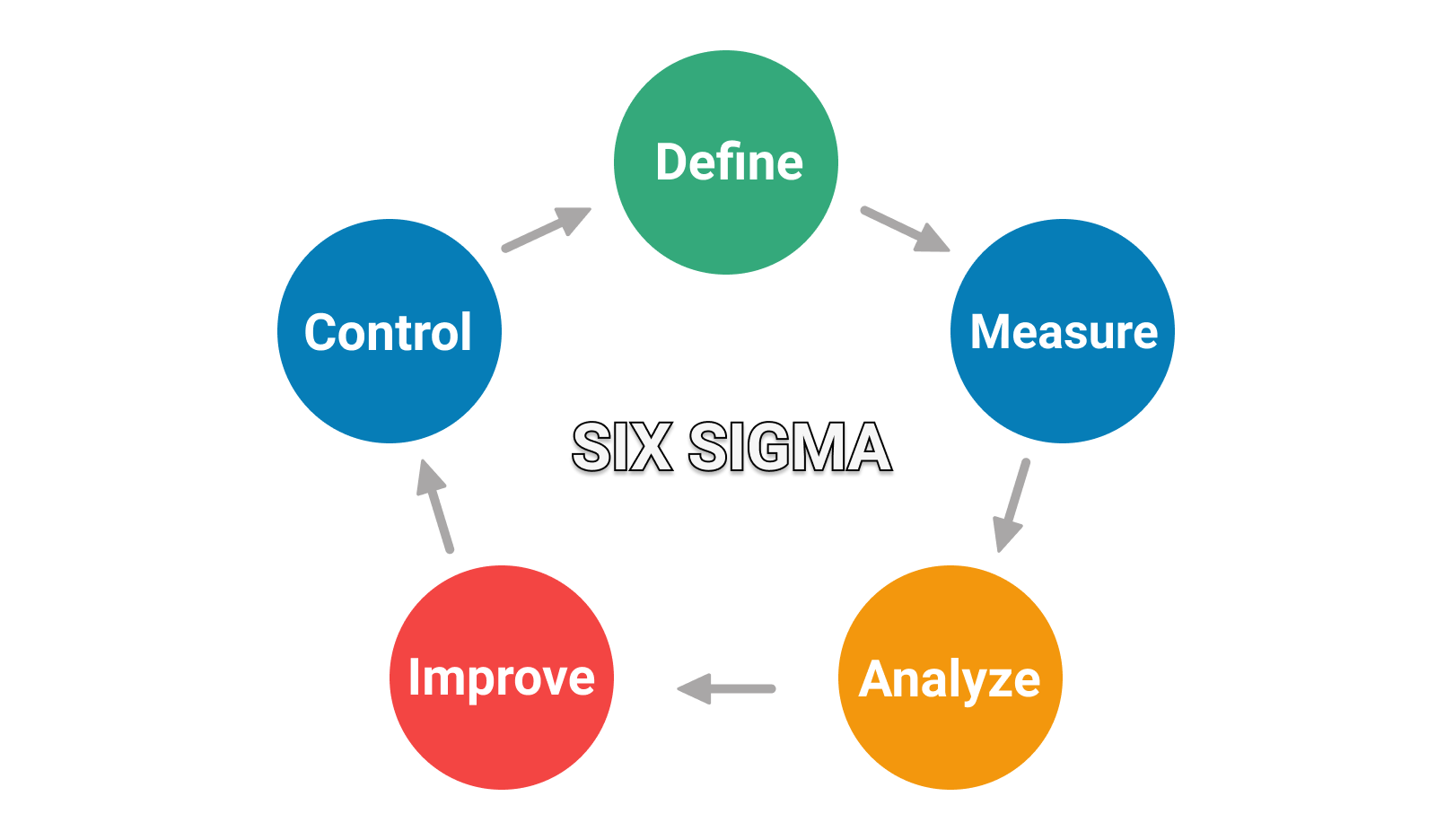Lean Six Sigma represents a methodology for overall organizational culture change. At its core, it is a process improvement approach for eliminating inefficiencies and improving work processes by identifying the defects’ root causes.
Lean Six Sigma is the smart combination of the Lean methodology focused on removing waste and optimizing flow, while the Six Sigma method seeks to identify and remove causing issues.
Let’s find out more about the two approaches individually.
A Brief History of Lean and Six Sigma
What Is Lean?
The Lean management methodology originates from Lean manufacturing, established by Toyota in the late 1940s to reduce all non-value-adding activities from the work process.

At the heart of the Lean management methodology lie three clear values: deliver from your customers’ perspective, eliminate all workflow waste, and continuously improve. In addition, to build an organizational culture, the concept suggests letting the people drive the change. Thus, the building blocks of Lean are its two pillars: respect for all people and continuous learning and improvement.
“The key to the Toyota way and what makes Toyota stand out is not any of the individual elements - but what is important is having all the elements together as a system.”
Taiichi Ohno, Industrial engineer and Businessman, Considered to be the father of the Toyota Production System
What Is Six Sigma?
The Six Sigma process improvement method dates back to the 1980s. Motorola’s manufacturing business first used the strategy to identify and reduce process defects and keep a low variability of its manufacturing processes.
The core of Six Sigma is:
- Focus on quantifiable and measurable financial results
- Management leadership and support is crucial for success
- Data-based decisions based on statistical data, rather than assumptions

The method employs the DMAIC (define; measure; analyze; improve; control) strategy, which includes 5-steps to improve an existing process, and the DMADV (define; measure; analyze; design; verify) strategy for creating a new one.
“Six Sigma is a quality program that, when all is said and done, improves your customer's experience, lowers your costs, and builds better leaders."
Jack Welch, GE's former CEO and Chairman
What Are the Lean Six Sigma Phases?
The 5 phases of Lean Six Sigma are as follows: Define, Measure, Analyze, Improve, and Control. Let’s review all of the stages and clarify what happens during each one of them.
- Define the problem from a customer and business perspective. During this phase, you need to answer the questions: What are the critical quality expectations defined by the customers? How do the stakeholders define the problem? As a result, you should clearly define the problem from a business perspective, its scope, and customer expectations.
- Measure the present process/product/service performance and answer the question: Does it comply with the quality expectations identified in the previous phase? The stage should determine each process step of your flow and match them with the specified quality criteria. As a result, you should assess the problem determined in the first phase and support your measurements with actual performance data.
- Analyze all gathered data to determine the root cause of the problem identified in the first phase. Then, it is time to use Lean analytical tools such as Value Stream Mapping, Just-In-Time (JIT), Pan-Do-Check-Act (PDCA), and Six Sigma problem-solving techniques to identify the root cause of the problem. At the end of the phase, everyone involved should be on the same page about: what the problem that needs addressing is, its source, scope, and boundaries.
- Improve once the root cause of the problem is clear and understood. Through collaboration efforts, you should be working on a reliable solution that will eliminate the problem and its cause during this stage, thus preventing its reoccurrence in the future. Data is crucial to determine if the suggested solution addresses the identified issue adequately. At the end of this stage, you should have a developed and tested solution alongside performance data.
- Control the applied solution by monitoring it. In this phase, you should establish acceptable performance criteria and create a plan for correcting any variations. This plan plays a crucial role in sustaining your improvements so far and preventing going back to the old ways.
What Are the Lean Six Sigma Techniques?
To confidently proceed to implement Lean Six Sigma, you first need to understand the founding principles behind the Lean mindset and the logic of the Six Sigma process. Then, to support your efforts, you can choose among a range of Lean Six Sigma techniques such as but not limited to:
- Kanban approach to workflow management where practices such as visualization of the work and limiting the work in progress help you maximize efficiency and improve continuously;
- Kaizen to shift towards a culture of self-development and continuous improvement;
- Value stream mapping to analyze and optimize your process delivery steps;
- 5S model to workplace optimization in five steps.
Benefits of Using Lean Six Sigma
Before you start the organizational change in your company, you have probably researched the expected benefits. We can divide these into two groups: organizational and personal. So, why is Lean Six Sigma important?
Organizational Benefits
If successfully applied, Lean Six Sigma will result in improved business performance and processes.
Simplified processes - By identifying and eliminating all wastes and inefficiencies from your processes, you’ll have a simpler workflow, easier to maintain and control. You will become faster, leaving little to no room for defects thanks to the simplicity of the entire process.
Predictable performance - On one hand, by eliminating all wasteful activities and processes from your workflow, you will create a simpler and more efficient flow. On the other, limiting recurring defects’ variability by identifying their root causes will establish a faster and easier process. As a result, with no waste and less variation, you will better predict your performance and set for improving it.
Increased profits/Decreased cost - Creating streamlined work where process steps are simple and all waste is eliminated will speed up your delivery and improve quality. This will create a potential for increased revenue. Also, by identifying and resolving defects’ root causes, you will decrease potential additional costs. All of that will help you to increase customer satisfaction and loyalty.
Personal Benefits
People’s benefits or characteristics developed thanks to the Lean Six Sigma approach are related to a mindset shift towards continuous improvement, self-development, and increased performance.
Analytical thinking - People become more analytical when breaking down complex issues into more manageable tasks through the Lean and Six Sigma approach. This helps identify root causes and creates a clear understanding of where you need to improve.
Effectiveness - Through identifying problems, their root causes, analyzing performance, proposing and applying a hands-on solution, people become more efficient in their role. More importantly, their readiness to act upon any situation, process, or problem creates a shared problem-solving attitude - a prerequisite for continuous improvement.
Project management skills - As the duties of Lean Six Sigma managers require communication on all organizational levels, from operations to strategic management, people have the opportunity to improve their project management skills and widen their understanding of the business.
What Are the Lean Six Sigma Roles and Responsibilities?
A Lean Six Sigma project employs four general roles to take part. The levels and definition of the responsibilities may differ depending on your business context. The people who decide to take those roles receive thorough training before acquiring the designated level of certification:
Yellow Belt - This level of certification provides an understanding of the structured methodology, tools, and techniques. A Lean Six Sigma project can comprise of many “Yellow Belts”.
Green Belt - The certification provides a detailed understanding of the Lean Six Sigma structure. “Green Belts” are usually leaders of small project/s in their area of expertise.
Black Belt - As subject matter experts, “Black Belts” are often engaged in cross-functional projects. They also act as coaches of “Green Belts” and can apply the Lean analytical tools. You can have many “Black Belts” in your organization.
Master Black Belt - There’s normally a single person with the highest level of certification in one organization. They are responsible for the Lean Six Sigma initiative (comprising of multiple projects) at a global level in the organization and report to C-level management.
Wrap Up
Embarking on an organizational change towards continuous improvement can be a daunting task if the change is not embraced across the company. It requires that all people and processes change. There should be a common understanding at every level in your organization about the goals and ground rules of the two approaches.
With a deeper understanding of what Lean Six Sigma principles are, the benefits it brings, and how it works, it is time to start the change!
While the methodologies will help you establish standards in your organization and develop a plan to maintain them with as minimum deviation as possible, the change should be global to be successful.
Businessmap is the most flexible software
to align work with company goals





